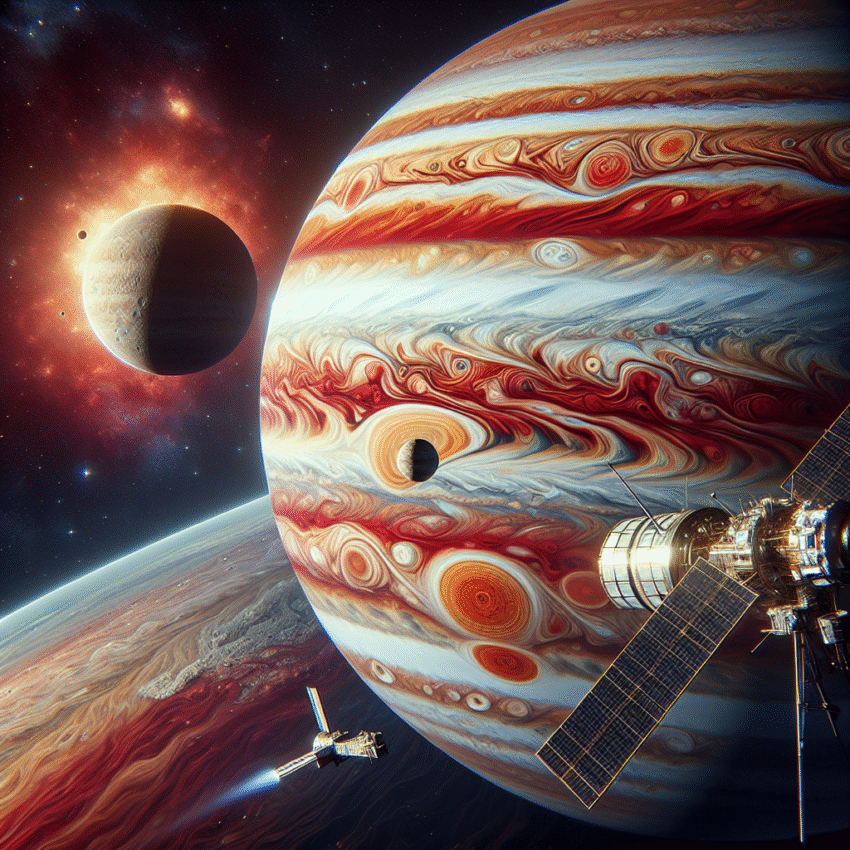NASA’s Latest Voyager Mission Unveils Stunning New Images of Jupiter’s Great Red Spot
In recent developments, NASA’s latest mission involving the Voyager spacecraft has provided mesmerizing new insights into Jupiter’s most famous feature, the Great Red Spot. The Voyager spacecraft, specifically Voyager 1 and Voyager 2, were launched in 1977 with the primary mission of exploring the outer planets of our solar system. Over the years, these probes have continued to send back invaluable data, making them some of the longest-running space missions in history. With cutting-edge technology and advanced imaging capabilities, the probes have sent clarity where there was once only conjecture about Jupiter’s colossal storm.
Voyager’s Journey and Scientific Significance
Voyager 1 and Voyager 2 were tasked with gathering data from Jupiter, Saturn, Uranus, and Neptune. As they travelled through the vastness of space, each encounter yielded groundbreaking findings. Jupiter, being the largest planet in our solar system, is a massive gas giant with fascinating atmospheric dynamics. The Great Red Spot, a persistent high-pressure region producing an anticyclonic storm that has raged for over 350 years, has intrigued scientists for generations. The latest images from the Voyager mission allow researchers to study this iconic storm in unprecedented detail.
Unprecedented Clarity from the Voyager Probes
The recently released images from the Voyager mission demonstrate a significant upgrade in clarity and detail compared to previous photographs taken by the Hubble Space Telescope and ground-based observatories. The high resolution captures intricate cloud structures and swirling atmospheric patterns in and around the Great Red Spot, exposing new features and dynamic interactions. The images reveal the complex, vortex-like motions that typify Jupiter’s dynamic atmosphere.
Atmospheric Dynamics of the Great Red Spot
The Great Red Spot measures about 1.3 times the diameter of Earth, making it an imposing feature of Jupiter’s atmosphere. Atmospheric science has long been fascinated by the storm’s longevity and stability. The latest images from the Voyager mission suggest that the storm is more dynamic than previously understood, with new smaller storms forming and interacting within its periphery. By analyzing the data gathered, atmospheric scientists aim to gain a deeper understanding of how these massive storms generate such incredible energy.
Composition and Color Analysis
One of the standout features of the new images from the Voyager mission is the rich coloration of the Great Red Spot. The stunning reds and browns of this atmospheric feature are believed to be a result of complex chemical reactions involving ammonium hydrosulfide and other trace chemicals in Jupiter’s atmosphere. As instruments onboard the Voyager probes captured the light spectrum reflected by these clouds, researchers could identify specific compounds and get a clearer picture of the storm’s composition.
The Role of Magnetic Fields
Jupiter’s magnetic field is also a contributing factor in the behavior of its atmospheric phenomena. Voyager’s instruments have been instrumental in mapping Jupiter’s magnetic field and its interaction with the solar wind. This magnetic field traps charged particles, influencing storm patterns and contributing to the ongoing development of features like the Great Red Spot. The new data will allow scientists to explore how these interactions may affect weather on Jupiter and how they compare to terrestrial weather systems.
Understanding Storm Dynamics Across the Solar System
Jupiter’s Great Red Spot serves as a unique laboratory for studying storm dynamics. The insights gained from the Voyager mission extend beyond Jupiter; they offer parallels to cyclone formations on Earth and other celestial bodies. By understanding how storms function on Jupiter, scientists can apply this knowledge to refine models for predicting weather patterns on Earth, improving forecasting systems in the process.
Citizen Science and Public Participation
As NASA continues to release the latest data and images from the Voyager mission, the space agency has engaged the public through citizen science initiatives. Enthusiasts and amateur astronomers are encouraged to participate in analyzing the data, contributing to our understanding of planetary science. This collaboration enhances the educational aspect of the mission and inspires future generations to engage with STEM fields.
Future Prospects and Ongoing Research
Looking forward, the Voyager mission continues to be a vital asset for planetary science. As the probes venture further into interstellar space, they will continue transmitting valuable data. Although they are now over 40 years old, the spacecraft have exceeded expectations in both durability and performance. Researchers will continue to analyze the images and data collected to glean new insights into Jupiter’s complex weather patterns and Pioneering techniques in imaging and data analysis can stem from this continued work.
The Legacy of the Voyager Mission
The legacy of the Voyager mission cannot be overstated. As they travel farther from Earth, the Voyager spacecraft are a testament to human curiosity and the quest for knowledge. The breathtaking images of Jupiter’s Great Red Spot are only a small part of their monumental contribution to astronomy and planetary science. Each new discovery reinforces our understanding of the universe and our place within it, driving future explorations and advancements in space technology.
Conclusion: A Journey Without End
NASA’s Voyager mission exemplifies the spirit of exploration and the pursuit of knowledge. With the stunning new images of the Great Red Spot, scientists gain a more detailed view of Jupiter’s tumultuous atmosphere. This unprecedented clarity opens new avenues for research and continues to spark curiosity about our solar system’s largest planet. As we still await more data from the Voyager probes, the scientific community remains excited and eager to unlock the secrets held within the depths of Jupiter’s mesmerizing storms.
Each revelation contributes to a better understanding of the solar system, offering a picture not only of Jupiter’s past and present but also of the mysteries that await exploration in the cosmos. With the legacy of the Voyager mission solidified, the awe-inspiring images serve as a reminder of our unyielding quest to better understand the universe we inhabit.




